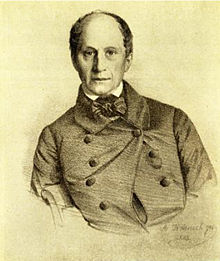Carl Heinrich Behn

Carl Heinrich Caspar Behn (born November 14, 1799 in Rendsburg ; † January 2, 1853 in Altona ) was the first and directing mayor of the city of Altona in Schleswig-Holstein from 1838 until his death .
Live and act
Behn first passed a legal exam ( cand. Jur. ) Before he became the registrar of the Schleswig-Holstein-Lauenburg chancellery on October 12, 1827 . On December 22, 1829, a few months after his appointment as real clerk, he took up a position as archivist , which he held for almost five years. On June 1, 1831, he obtained the title of a real chancellery and on July 3, 1833 that of a judiciary . From September 16, 1834, he worked as a police master and councilor in Flensburg .
The Danish king appointed Behn on 22 May 1838 for the first and directing Mayor of Altona. He held this post for life. His appointment was made at the request of Chief President Conrad Daniel von Blücher-Altona , who hoped that this would provide relief. After Blücher's death in 1845, Behn also took over the representation of the Copenhagen government in Altona as administrator of the senior presidency for a year and put its will into practice. He took up the same office permanently from 1848.
He is regarded as a forward-looking city planner who created the avenue leading to Hamburg (today Max-Brauer-Allee ), an important bypass road around the then built-up area of Altona. For the first time there was a regular traffic connection between Altona and Hamburg. Three horse-drawn omnibus lines operated by hauliers from Altona and Hamburg ran from 1839. From 1840 to 1841, Behn had the New Harbor built west of Grosse Elbstrasse . During his tenure, he also decided on the connection of the Altona-Kiel Railway , which opened in 1844, to the Altona city area. He also had Marktstrasse (now Ehrenbergstrasse ) built.
Shortly before his death, on New Year's Eve 1852, Behn, in his capacity as administrator, signed a notice from the Danish government that deprived Altona of all customs privileges. This led to an impairment of Altona's economy, as it made it difficult to sell goods beyond the customs borders of neighboring countries.
Behn died on January 2, 1853 at the age of 53 in Altona. He left seven children behind, three more had died before him. He was buried in the Norderreihen cemetery. However, his grave was completely destroyed in 1943.
The Behnbrunnen still reminds of Carl Heinrich Caspar Behn today . In 1861 the Behnstraße in Altona was named after him and after 1888 a further piece was added so that it flows into the Palmaille .
literature
- Commemorative publication on the 100th anniversary of the death of Mayor Carl Heinrich Caspar Behn. Altona Citizens' Association, 1953.
- Gertrud Nordmann: Schleswig-Holstein officials 1816 - 1848. Schleswig-Holstein State Archives, Schleswig 1997, ISBN 3-931292-56-8 .
- Who was Carl Heinrich Caspar Behn? In: Mien leeves Altona. News from Altona's present and past. Internet newspaper No. 16 of the Altona City Archives, Hamburg, March 2010, pp. 45–51.
- From the life and work of the Altona mayor Caspar Behn. In: Mien leeves Altona. News from Altona's present and past. Internet newspaper no. 17 of the Altona City Archives, Hamburg, May 2010, pp. 71–77.
Individual evidence
- ^ Gertrud Nordmann: Schleswig-Holstein Officials 1816 - 1848. Schleswig-Holstein State Archives, Schleswig 1997, p. 9.
- ^ Gertrud Nordmann: Schleswig-Holstein Officials 1816 - 1848. Schleswig-Holstein State Archives, Schleswig 1997, p. 6.
- ↑ Gertrud Nordmann: Schleswig-Holstein officials 1816 - 1848. Schleswig-Holstein State Archives, Schleswig 1997, p. 365/367.
- ^ Gertrud Nordmann: Schleswig-Holstein Officials 1816 - 1848. Schleswig-Holstein State Archives, Schleswig 1997, p. 259.
- ^ Schleswig-Holstein advertisements. Schleswig-Holstein, Ministry of Justice, 1838, p. 233.
- ↑ a b Mien leeves Altona. Internet newspaper No. 17 of the Altona City Archives, 2010, pp. 72–73.
- ↑ Mien leeves Altona. Internet newspaper No. 16 of the Altona City Archives, 2010, p. 45.
- ↑ a b Mien leeves Altona. Internet newspaper no. 17 of the Altona city archive, 2010, pp. 76–77.
- ↑ Mien leeves Altona. Internet newspaper No. 17 of the Altona City Archives, 2010, pp. 70–71.
| personal data | |
|---|---|
| SURNAME | Behn, Carl Heinrich |
| ALTERNATIVE NAMES | Behn, Carl Heinrich Caspar (full name) |
| BRIEF DESCRIPTION | Mayor of Altona |
| DATE OF BIRTH | November 14, 1799 |
| PLACE OF BIRTH | Rendsburg |
| DATE OF DEATH | January 2, 1853 |
| Place of death | Altona |